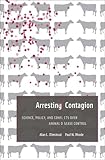Arresting Contagion : Science, Policy, and Conflicts over Animal Disease Control / Alan L. Olmstead.
Material type: TextPublisher: Cambridge, MA : Harvard University Press, [2015]Copyright date: ©2015Description: 1 online resource (430 p.) : 11 halftones, 15 maps, 9 graphs, 5 tablesContent type:
TextPublisher: Cambridge, MA : Harvard University Press, [2015]Copyright date: ©2015Description: 1 online resource (430 p.) : 11 halftones, 15 maps, 9 graphs, 5 tablesContent type: - 9780674728776
- 9780674736047
- 636.089/69 23
- online - DeGruyter
- Issued also in print.
| Item type | Current library | Call number | URL | Status | Notes | Barcode | |
|---|---|---|---|---|---|---|---|
 eBook
eBook
|
Biblioteca "Angelicum" Pont. Univ. S.Tommaso d'Aquino Nuvola online | online - DeGruyter (Browse shelf(Opens below)) | Online access | Not for loan (Accesso limitato) | Accesso per gli utenti autorizzati / Access for authorized users | (dgr)9780674736047 |
Frontmatter -- Contents -- Figures and Tables -- 1. An Enduring Struggle -- 2. Livestock Disease Environment and Industry Dynamics -- 3. The Battle to Create the Bureau of Animal Industry -- 4. The BAI in Action. -- 5. Bad Blood. -- 6. Contagions and Crises. -- 7. The Hog Cholera Puzzle. -- 8. Trichinosis, Trade, and Food Safety -- 9. The Benevolence of the Butcher -- 10. Bovine Tuberculosis and the Milk Problem -- 11. The Eradication of Texas Fever -- 12. An Impossible Undertaking -- 13. Getting Off the Fix -- 14. The Mirror of the Past -- Abbreviations -- Notes -- Bibliography -- Acknowledgments -- Index
restricted access online access with authorization star
http://purl.org/coar/access_right/c_16ec
Over sixty percent of all infectious human diseases, including tuberculosis, influenza, cholera, and hundreds more, are shared with other vertebrate animals. Arresting Contagion tells the story of how early efforts to combat livestock infections turned the United States from a disease-prone nation into a world leader in controlling communicable diseases. Alan Olmstead and Paul Rhode show that many innovations devised in the fight against animal diseases, ranging from border control and food inspection to drug regulations and the creation of federal research labs, provided the foundation for modern food safety programs and remain at the heart of U.S. public health policy. America's first concerted effort to control livestock diseases dates to the founding of the Bureau of Animal Industry (BAI) in 1884. Because the BAI represented a milestone in federal regulation of commerce and industry, the agency encountered major jurisdictional and constitutional obstacles. Nevertheless, it proved effective in halting the spread of diseases, counting among its early breakthroughs the discovery of Salmonella and advances in the understanding of vector-borne diseases. By the 1940s, government policies had eliminated several major animal diseases, saving hundreds of thousands of lives and establishing a model for eradication that would be used around the world. Although scientific advances played a key role, government interventions did as well. Today, a dominant economic ideology frowns on government regulation of the economy, but the authors argue that in this case it was an essential force for good.
Issued also in print.
Mode of access: Internet via World Wide Web.
In English.
Description based on online resource; title from PDF title page (publisher's Web site, viewed 30. Aug 2021)


